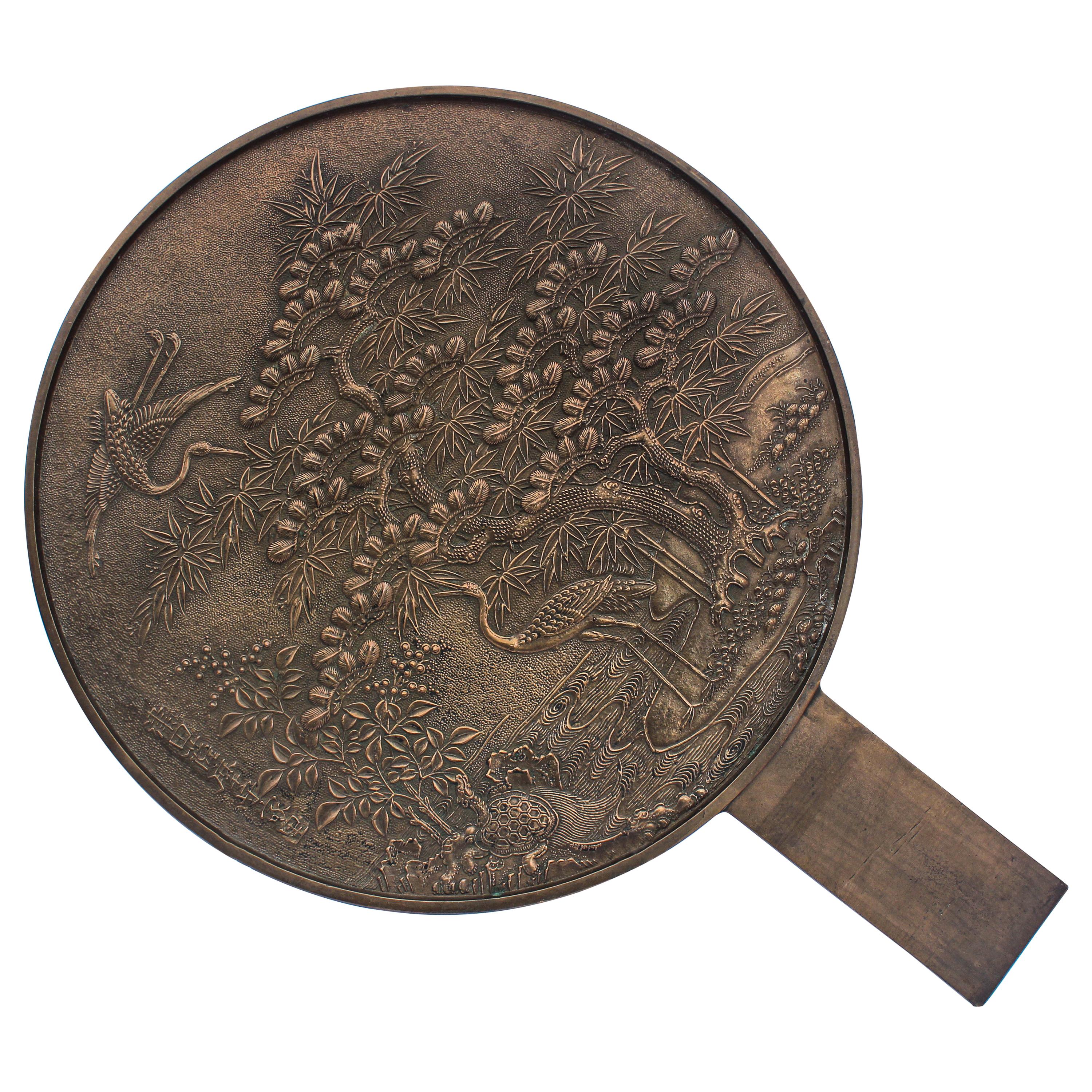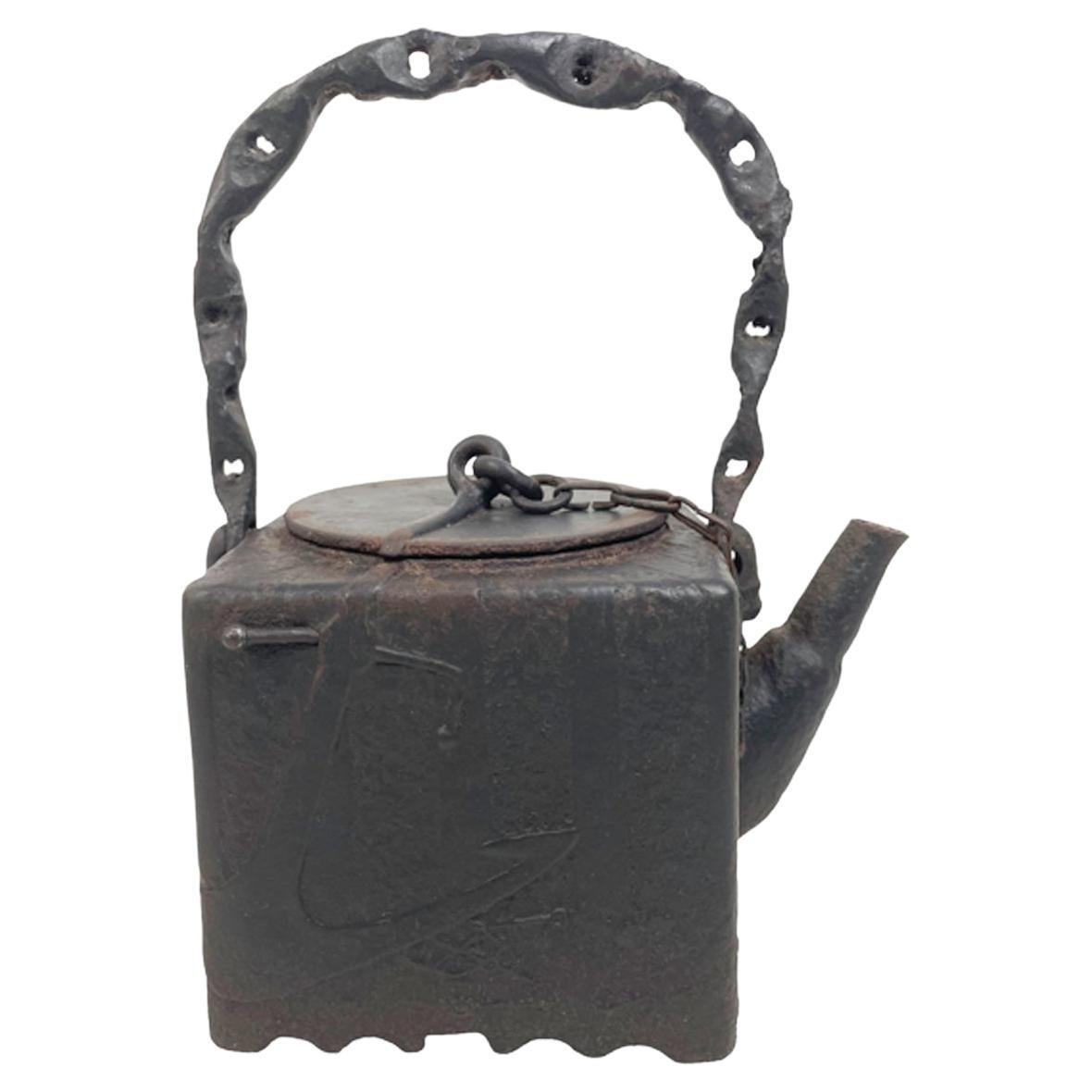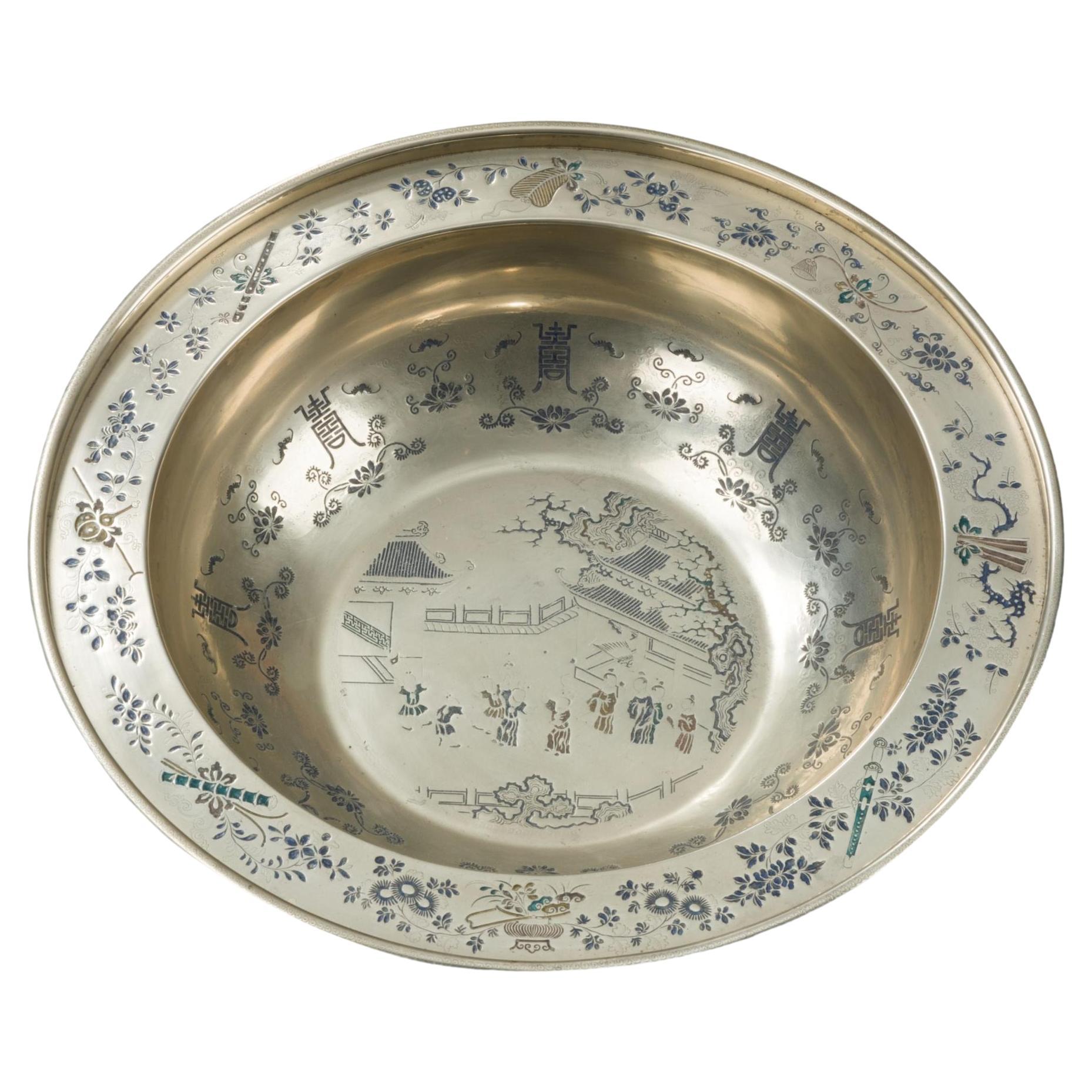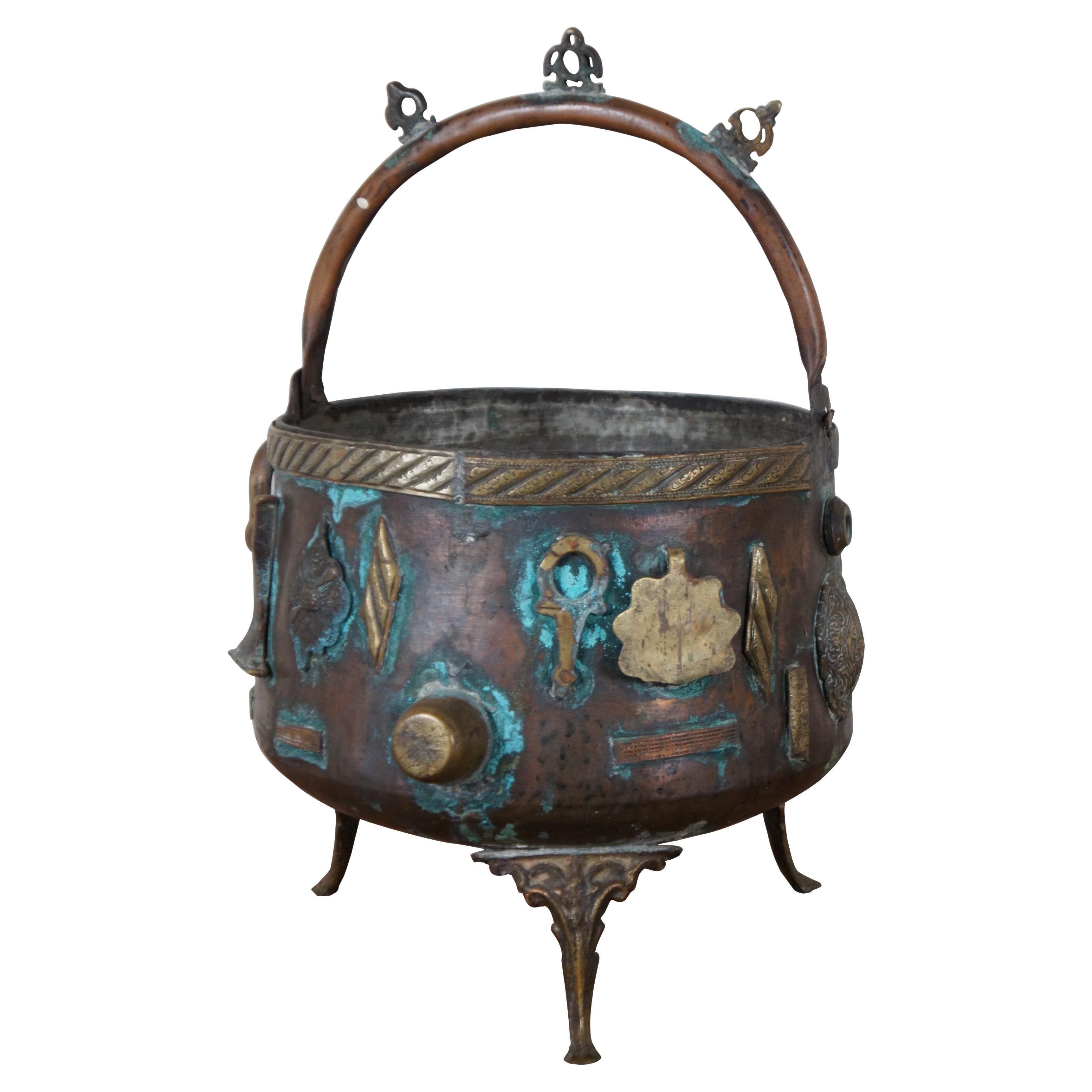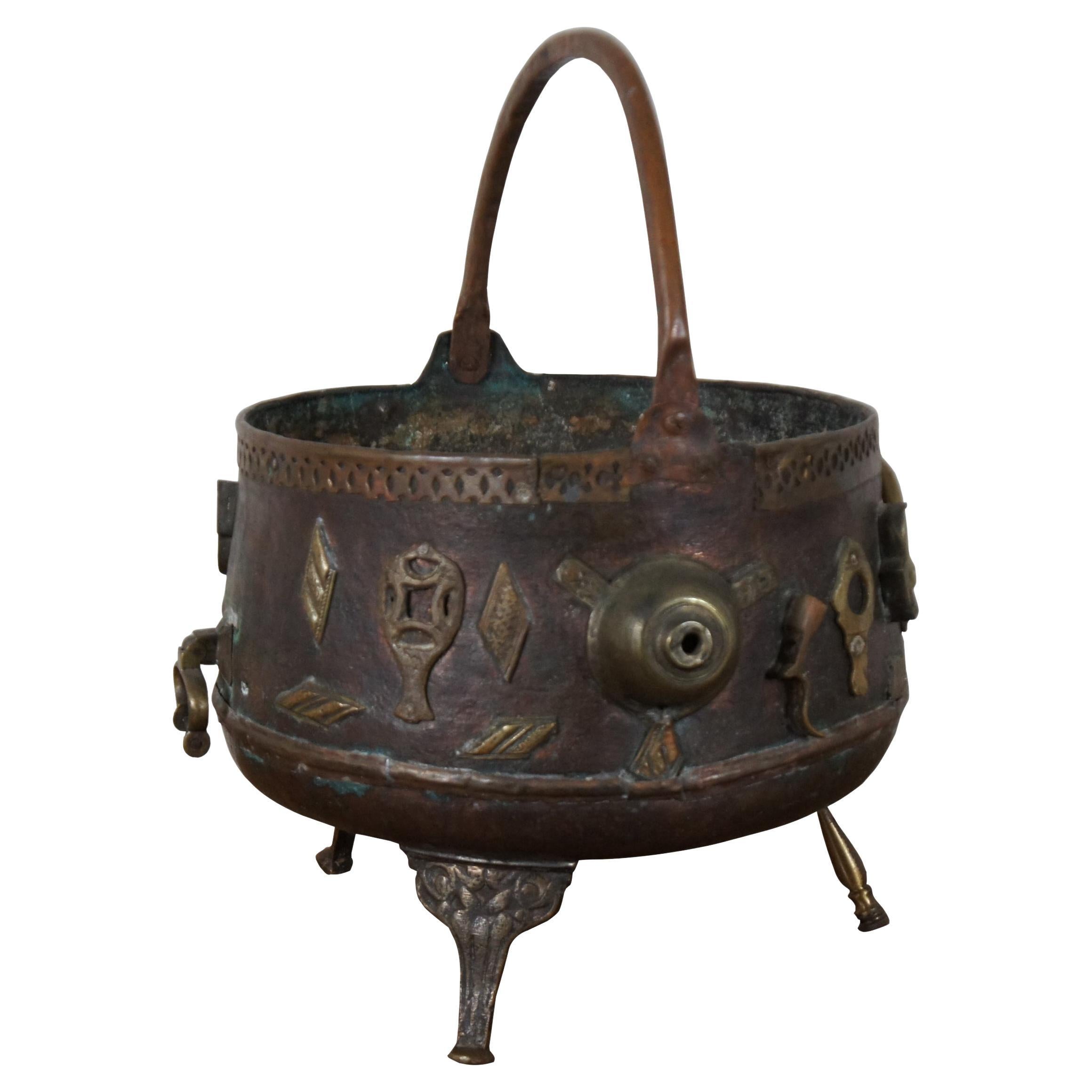Items Similar to Japanese Cast Iron Tea Kettle Water Pot Tetsubin, Late 19th Century
Want more images or videos?
Request additional images or videos from the seller
1 of 8
Japanese Cast Iron Tea Kettle Water Pot Tetsubin, Late 19th Century
About the Item
A large, heavy and uniquely shaped Japanese cast iron teapot tetsubin without top.
Likely late 19th-early 20th century.
From a collection of Japanese antiques and artifacts.
Perfect for your collection or fantastic standalone accent piece.
Dimensions: 11" high, 9.5" diameter.
- Dimensions:Height: 11 in (27.94 cm)Diameter: 9.5 in (24.13 cm)
- Style:Meiji (Of the Period)
- Materials and Techniques:
- Place of Origin:
- Period:
- Date of Manufacture:Late 19th-Early 20th Century
- Condition:Wear consistent with age and use. No kettle lid and some wear to end of spout (please see photos) natural with age otherwise in good vintage condition. A very eye catching work overall.
- Seller Location:Studio City, CA
- Reference Number:1stDibs: LU2254315664671
About the Seller
4.9
Platinum Seller
These expertly vetted sellers are 1stDibs' most experienced sellers and are rated highest by our customers.
1stDibs seller since 2016
768 sales on 1stDibs
Typical response time: <1 hour
- ShippingRetrieving quote...Ships From: Studio City, CA
- Return PolicyA return for this item may be initiated within 7 days of delivery.
More From This SellerView All
- 19th Century Asian or Indian Primitive Bronze Cow Bell Original Leather StrapsLocated in Studio City, CAA fantastic Primitive piece. Hefty and well detailed with clear signs of age and use. Nice patina. Appears to have original leather straps. Likely from India or Southeast Asia. ...Category
Antique 19th Century Asian Primitive Metalwork
MaterialsBronze
- Japanese Temple Shrine Buddhist Monk Juzu Prayer Wood Beads Mala Rosary NecklaceLocated in Studio City, CAA truly magnificent and special work - this beautiful and exceptionally long string of Japanese handcrafted natural wood (perhaps rosewood) Buddhist Juzu mala beads with four large square-like beads called shitenshu beads said to represent the Four Heavenly Kings: Jikko-Ten, Zocho-ten, Hiromoku-ten, and Tamon-ten (Since there are four square beads, the denomination is probably Tendai or Nichiren sect). These rosary-type prayer bead necklaces were used by Buddhist monks in temple prayers / rituals and worn by Samurai as amulets of protection. We have not come across another set of Juzu beads...Category
Antique 19th Century Japanese Meiji Sculptures and Carvings
MaterialsWood
- Japanese Temple Buddhist Monk Samurai Juzu Prayer Beads Mala Rosary NecklaceLocated in Studio City, CAA truly magnificent and special work - this beautiful and exceptionally long string of Japanese hand-crafted natural wood (perhaps Rosewood) Buddhist Juzu mala beads. These rosary-type large prayer bead necklaces were used by Buddhist monks in temple prayers/rituals and worn by Samurai as amulets of protection. During the Edo period, Buddhist priests/monks and samurai warriors used to wrap the beads around their bodies and use the beads in their worshipping and meditation ceremonies. After reading the sutra once, one bead would be moved (some sects used them instead of wooden tally counters). It would take a tremendous amount of intense concentration and physical stamina to read the sutra while holding and counting/moving each individual prayer bead as well as a copious amount of time to move all the prayer beads to complete the sutra cycle. We have not come across another set of Juzu beads...Category
Antique Early 19th Century Japanese Edo Sculptures and Carvings
MaterialsWood
- Japanese Wood Gilt Lacquer Buddha Buddhist Temple Traveling Zushi Shrine AltarLocated in Studio City, CAA wonderful Japanese Buddhist portable traveling zushi shrine altar with Amida Buddha (Amitabha) concealed inside the folded wood doors. This work dat...Category
Early 20th Century Japanese Showa Sculptures and Carvings
MaterialsMetal, Gold Leaf
- Japanese Buddhist Monk Priest 7 Column Silk Brocade Kesa Ceremonial Temple RobeLocated in Studio City, CAA wonderful, beautifully ornamented and somewhat rare fully intact Japanese Buddhist monk/ priest's Kesa ceremonial silk robe featuring various colorful birds in flight. Kesa (which came from the Chinese word "kasaya") robes have been handmade/handstitched by monks/priests as an act of devotion as ceremonial robes for centuries in various Asian cultures (Japanese, Chinese, Korean, Vietnamese, Indian, etc.). The kesa is a rectangular garment designed to be worn over the left shoulder (see example image). The robes are made (often in a patchwork column pattern ranging from five, seven, nine or more pannels) specifically for fully ordained Buddhist monks, priests and nuns and are made from donations of exquisite textiles from wealthy patrons of Japanese Buddhist temples. The robes were used in daily ceremonies, temple gatherings, and private meditation. Antique Kesa robes...Category
Mid-20th Century Japanese Showa Textiles
MaterialsTextile, Brocade, Silk
- Japanese Edo Buddhist Monk Priest 7 Column Silk Brocade Kesa Ceremonial RobeLocated in Studio City, CAA wonderful, brightly coloured and somewhat rare fully intact Japanese Buddhist monk/ priest's Kesa ceremonial silk robe. Kesa (which came from the Chinese word "kasaya") robes have been handmade/handstitched by monks/priests as an act of devotion as ceremonial robes for centuries in various Asian cultures (Japanese, Chinese, Korean, Vietnamese, Indian, etc). The kesa is a rectangular garment designed to be worn over the left shoulder (see example image). The robes are made (often in a patchwork column pattern ranging from five, seven, nine or more pannels) specifically for fully ordained Buddhist monks, priests and nuns and are made from donations of exquisite textiles from wealthy patrons of Japanese Buddhist temples. The robes were used in daily ceremonies, temple gatherings, and private meditation. Antique Kesa robes...Category
Antique 19th Century Japanese Edo Textiles
MaterialsTextile, Brocade, Silk
You May Also Like
- 19th Century Oriental Bronze Japanese Kagami Handled MirrorLocated in North Hollywood, CAAntique traditional Oriental bronze Japanese Kagami handled Mirror. An exceptional and stunning Japanese bronze handled mirror called Kagami. Large and heavy bronze handle mirror ...Category
Antique Late 19th Century Japanese Meiji Metalwork
MaterialsBronze
- Japanese Cast Iron Tea Pot (Tetsubin) of Square Form with Anchor & Sword, SignedLocated in Chapel Hill, NC19th Century Japanese cast iron teapot or tetsubin of cube form with anchor chain handle, one side cast with a navel anchor continuing around the back and to the top where the top ri...Category
Antique Late 19th Century Japanese Folk Art Metalwork
MaterialsIron
- Chinese Paktong Basin, 19th CenturyLocated in Lymington, HampshireA Chinese paktong basin, engraved with scenes of many children at play and before pagodas, within borders of shou characters, bats and flowerheads, the flattened rim with vases of flowers and lingzhi, swords, lotus pods...Category
Antique 19th Century Japanese Meiji Metalwork
MaterialsMetal
- Antique 19th Century Chinese Bronze Ornate Cauldron Pot Planter TripodLocated in Dayton, OHAntique bronze cauldron with tripod base and swivel handle, decorated with etched ornate medallions going along the body. Circa 19th century. Proven...Category
Antique 19th Century Chinoiserie Metalwork
MaterialsBronze
- Antique 19th Century Chinese Bronze Ornate Cauldron Pot Planter TripodLocated in Dayton, OHAntique bronze cauldron with tripod base and swivel handle, decorated with etched ornate medallions going along the body. Circa 19th century. Proven...Category
Antique 19th Century Chinoiserie Metalwork
MaterialsBronze
- Japanese Cast Bronze "Longevity" Mirror, Edo Period, 18th Century, JapanLocated in Austin, TXA heavy and finely cast Japanese bronze mirror with longevity symbols, Edo Period, 18th century, Japan. The small, round mirror with high walls...Category
Antique Late 18th Century Japanese Edo Metalwork
MaterialsBronze
